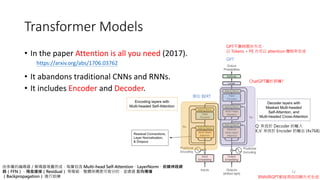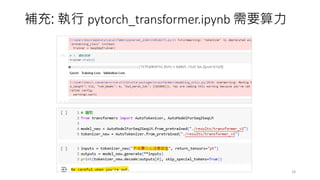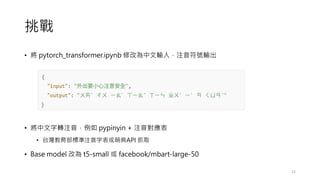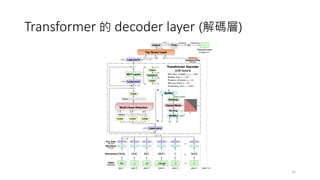Ad
Seq2seq Model introduction with practicing hands on coding.pdf
- 2. About me 2 • Education • NCU (MIS)、NCCU (CS) • Experiences • Telecom big data Innovation • Retail Media Network (RMN) • Customer Data Platform (CDP) • Know-your-customer (KYC) • Digital Transformation • LLM Architecture & Development • Research • Data Ops (ML Ops) • Generative AI research • Business Data Analysis, AI
- 3. Tutorial Content 3 Homework Transformer 三種架構 • 理解與生成機制 • RNN 問題 (梯度消失/爆炸) • (非序列資料) VAE 應用,如推薦系統 Seq2seq 架構 • Encoder-only (BERT model) • Decoder-only (GPT model) • Encoder-decoder (T5, BART model)
- 4. Code • Sample code • https://drive.google.com/drive/folders/1wEdGUZbqvmVNwS8AtsO5hXODpK Dn6Qk3?usp=sharing 4
- 5. Seq2seq (文字序列應用案例) • 輸入:我今天想吃拉麵 • Encoder: • 【理解】你在說什麼,它會先讀完整段話,形成一個內部的語意理解 • Decoder: • 根據理解回答你,像是一步一步【生成】:我知道附近哪裡有拉麵店! 5
- 6. Seq2seq (結合2個RNN) 6 用來處理序列轉換任務,例如: 【機器翻譯、對話系統、文本摘要】 利用 RNN 的架構進行逐一讀入,將【理解】轉換成 hidden state ,輸出一個壓縮過的語意向量 接收字詞的輸入與來自 Encoder 的 hidden state,這樣 才能正確地翻譯並【生成】對應的輸出序列 壓 縮
- 7. • 仍然有梯度的問題 • 【長文本】容易在 encoder 階段被【遺忘】,導致 decoder 無法生成【對齊 語意】 • 遺忘機制在實務上效果還是有限,有可能【錯判】資訊的重要性 • Decoder 階段是序列式生成字詞一步接一步 (greedy/ beam search),屬於 【自回歸生成】,這限制了整體語意【上下文】掌握能力 • RNN 為【時間步依賴 (Time step)】結構 (一步接一步),無法【平行】運算 • LSTM/GRU 屬於單層或少數層推疊,很難表現出語意、語法等多層次結構 7 因為不斷學習每一個字詞,然後再遺忘,避免訓練階段梯度爆炸 當輸入序列太長時,誤差反向傳播回去會發生:計算後的梯度會被不斷縮小 (梯度消失) 或 梯度被不斷放大 (梯度爆炸) Seq2seq (結合2個RNN)
- 8. • 可視為 seq2seq 的一種特殊形式,但它的輸出目標是輸入本身, 不是【序列】資料 • 採用機率空間 (latent space) 的 encoder-decoder 架構,並不是 為了解碼語言,而是為了學習一個隱變量生成模型 • 模型學會使用者對物品偏好的【隱藏分佈】,然後透過這個潛在 向量來生成對其他物品的預測分佈 8 加入了 latent space 的機率分布假設 (通常是高斯分布),使模型可以學到更平滑、更有泛化能力的隱變量空間 Seq2seq (非序列資料) VAE (Variational Autoencoders)
- 9. • 與 seq2seq 相同處 • 與 seq2seq 不同處 9 特點 說明 Encoder-Decoder 架構 都具有 【輸入】=> 【壓縮】 => 【輸出】 隱藏空間 (Latent space) 將輸入資料轉為某種內部表示,再生成輸出 用於生成任務 都可以用來產生某種輸出,如: 句子、推薦分數 特點 VAE Seq2seq 中間的 latent 表示 機率分佈 (有 μ, σ) + 抽樣機制 單一 hidden state 向量 學習目標 (計算損失) 最大化 KL + 重建損失 生成與實際的 Cross entropy 應用範圍 壓縮、生成、推薦、圖像重建 機器翻譯、對話、摘要 VAE 中使用 KL 散度將 latent space 正則化為標準常態 N(0,1) 目的就是每個使用者評分高低會有不同 Seq2seq (非序列資料) VAE (Variational Autoencoders)
- 10. • 輸入: • 五個使用者對於十個物品評分,有些物品是空的 (表示沒評分) • Encoder (編碼使用者偏好分佈): • 將這個稀疏的評分向量轉為潛在空間 Z ~ N (μ, σ²) • Decoder (重建完整評分向量): • 將 Z 表徵傳回 decoder,產生對所有物品的預測分數 • Loss 計算: • 重建損失,已知評分 vs 預測評分 • KL 散度損失: 讓潛在空間 (使用者的Z 表徵) 接近標準常態分佈 10 (Z 表徵為使用者個人偏好) • 標準常態分佈(平均值為 0,變異數為 1) • 一般常態分佈 (平均值為 μ,變異數為 σ² ) VAE.ipynb VAE_encoder_Z.ipynb MSE(x_hat, x) 衡量每位使用者的 μ 與 σ 距離標準常態分佈有多遠,距離越遠就要大幅調乘權重參數 Seq2seq (非序列資料) VAE (Variational Autoencoders)
- 11. Transformer Models • They are a more recent and highly effective architecture for sequence modeling. • They move away from recurrence and rely on a self-attention mechanism to process sequences in parallel and capture long-term dependencies in data, making them more efficient than traditional RNNs. • Self-attention mechanisms to weight the importance of different parts of input data. • They have been particularly successful in NLP tasks and have led to models like BERT, GPT, and others. 11
- 12. • In the paper Attention is all you need (2017). • It abandons traditional CNNs and RNNs. • It includes Encoder and Decoder. 12 https://arxiv.org/abs/1706.03762 由多層的編碼器/解碼器堆疊而成,每層包含 Multi-head Self-Attention、LayerNorm、前饋神經網 路(FFN)、殘差連接(Residual) 等模組,整體架構是可微分的,並透過 反向傳播 (Backpropagation) 進行訓練 Q: 來自於 Decoder 的輸入 K,V: 來自於 Encoder 的輸出 (4x768) 類似 BERT GPT GPT不靠時間步方式, 以 Tokens + PE 方式以 attention 機制來生成 ChatGPT屬於那種? Transformer Models RNN與GPT都採用自回歸方式生成
- 13. • How are you? • 你好嗎? Tokenizer <CLS> “How” “are” “you” “?” <SEP> Vocabulary How 1 are 10 you 300 ? 4 Word to index mapping d=768 Add PE (Positional Encoding) Multi-Head- Attention (HMA) In parallel Feed Forward Residual Connection N O R M Residual Connection N O R M Block Block Block context vectors BERT 的模型約有 30,000個 tokens,這些常用的詞、詞根、 子詞(subword) 編上編號 embedding 逐元素相加: 這樣模型就知道哪些詞 是出現在前面、哪些在 後面,才能理解語序 BERT 有 12 個 Block,BERT Large 有 24 個 Block 用 sin 和 cos 波形來表示不同位置,奇數用 cos,偶數用 sin; 每個位置 pos 對應一組固定向量 機器翻譯 計算的方向 Transformer Models Encoder 階段 何謂 Token?
- 14. Multi-head-attention • Attention mechanism: • Select more useful information from words. • Q, K and V are obtained by applying a linear transformation to the input word vector x. (token 經過 word embedding 之後就是 x) • Each matrix W can be learned through training. 14 Q: Information to be queried K: Vectors being queried V: Values obtained from the query (多頭的意思,想像成 CNN 中多個卷積核的作用(抓取特徵值) => 【多個注意力】機制 RNN 難以學到遠距離的依賴關係,因此需要導入 attention 機制。 1. how are you 經過 Q· Kᵀ 之後為注意力分數 [0.8, 1.2, -0.4] ,再透過 softmax 為 [0.31, 0.52, 0.17] ,這表示how應該要關注的字詞為 are 因為有 52% 2. 接下來 how 這個詞 [0.31 · vhow+0.52 · vare+0.17 · vyou],這會有 768維 3. 三個字詞算完,一共有 [3x768] 進入 Layer Norm
- 15. 15 模型透過 Self-Attention 機制,在這 128K 的 token 中動態找出: • 哪些字詞 (Tokens) 彼此有關係 • 哪些部分該被【關注】 • 哪些可忽略 Multi-head-attention 1. 每個 token 的向量會分別經過三個矩陣變換,產生 Q, K, V 2. 利用 Q 與所有 K 的內積來計算關聯分數,再經 softmax 得到注意力分數 (機率) 3. 權重越高,表示模型對該 token 給予越高的注意力
- 16. • Bidirectional Encoder Representations from Transformers • 使用 Encoder 進行編碼,採用 self-attention 機制在編碼 token 同時考慮上下 文的 token,上下文的意思就是雙向的意思 (bidirectional) • 採用 Self-Attention多頭機制提取全面性信息 • 採用猜字的方式進行學習,稱為 Masked Language Model (MLM) ,以 Cross entropy 計算損失,以達到模型收斂效果 • 使用 Transformer 的 Encoder 進行特徵提取,可說 Encoder 就是 BERT模型 16 當訓練的時候,雙向的意思就是 => 透過 MASK,會同時看到【今天天氣】 [MASK] 【,我想吃冰淇淋】 當預測字詞【很】的時候,雙向的意思就是 => 會同時看到【我今天】 【開心】 Transformer Models (BERT) Encoder-only 處理「這部電影會很好看,結果非常無聊」時,它同時看到整句的前後文,知道「非常無聊」才是真正的情緒, 不會被「很好看」這個片段誤導。 pytorch_bert.ipynb
- 17. 17 Context Vector (K,V) B O S 你 好 嗎 你 好 嗎 ? max max max max 你 0.8 好 0 嗎 0.1 … … END 0 ? E N D max Add PE Masked MHA Cross Attention Feed Forward 你 1 好 0 嗎 0 … … … 0 Ground truth Minimize cross entropy Embedding 1. 剛開始進行模型訓練時,QKV 參數都是隨機值,剛開始的關注詞根本不具參考性 2. 每做完一次訓練就是 (FFN + Backward),根據 Loss 的結果進行 Backward 3. 更新 QKV 讓 attention 的分數越來越有判斷力 pytorch_transformer.ipynb (Token-level loss) 1. 透過 Encoder 的 Context Vector (K,V ) 2. 生成第一個字詞:你 (softmax(Linear(Context Vector))) 3. 將字詞:你,作為Q,進行KV查表後,生成字詞:好… 如果沒有 Context Vector 輸入, 稱為 Decoder-only 模型,例如: ChatGPT 該模型為 Causal Masking 方式: 整合 QA pairs 問 題資料集為一個欄位,一起訓練 只看過去字詞(tokens),遮住未來字詞(tokens) Helsinki-NLP/opus-mt-zh-en ·Hugging Face Transformer Models Decoder 階段 當它看到「我以為這部電影會很好看,結果」, 它只能依靠前面的字猜「接下來會說什麼」, 所以「非常無聊」這個反轉情緒,它是之後才看到的,不能提前感知 機器翻譯
- 18. 補充: 執行 pytorch_transformer.ipynb 需要算力 18
- 19. HuggingFace LLM models • Model card: • https://huggingface.co/TheBloke/Llama-2-7B-Chat-fp16 • 何謂預訓練模型 ? 如何啟動本地端模型? • 了解訓練資料集、建模、評估、推論 • 下一步 ? 19 hf_pytorch_pretrain_gpt.ipynb https://ollama.com
- 20. Homework • 改寫 HW03.ipynb,將生活居家.csv 與 彩妝保養.csv 進行分類 • 輸入「簡單的外型設計,香氣清新」 • 得到「生活居家」 分類結果 20
- 21. • 將 pytorch_transformer.ipynb 修改為中文輸入,注音符號輸出 • 將中文字轉注音,例如 pypinyin + 注音對應表 • 台灣教育部標準注音字表或萌典API 抓取 • Base model 改為 t5-small 或 facebook/mbart-large-50 21 挑戰
- 22. Transformer 的 decoder layer (解碼層) 22














![Multi-head-attention
• Attention mechanism:
• Select more useful information from words.
• Q, K and V are obtained by applying a linear transformation to the input word
vector x. (token 經過 word embedding 之後就是 x)
• Each matrix W can be learned through training.
14
Q: Information to be queried
K: Vectors being queried
V: Values obtained from the query
(多頭的意思,想像成 CNN 中多個卷積核的作用(抓取特徵值) => 【多個注意力】機制
RNN 難以學到遠距離的依賴關係,因此需要導入 attention 機制。
1. how are you 經過 Q·
Kᵀ 之後為注意力分數 [0.8, 1.2, -0.4] ,再透過 softmax 為 [0.31,
0.52, 0.17] ,這表示how應該要關注的字詞為 are 因為有 52%
2. 接下來 how 這個詞 [0.31 ·
vhow+0.52 ·
vare+0.17 ·
vyou],這會有 768維
3. 三個字詞算完,一共有 [3x768] 進入 Layer Norm](https://image.slidesharecdn.com/seq2seqmodel-250504135505-a6930420/85/Seq2seq-Model-introduction-with-practicing-hands-on-coding-pdf-14-320.jpg)

![• Bidirectional Encoder Representations from Transformers
• 使用 Encoder 進行編碼,採用 self-attention 機制在編碼 token 同時考慮上下
文的 token,上下文的意思就是雙向的意思 (bidirectional)
• 採用 Self-Attention多頭機制提取全面性信息
• 採用猜字的方式進行學習,稱為 Masked Language Model (MLM) ,以 Cross
entropy 計算損失,以達到模型收斂效果
• 使用 Transformer 的 Encoder 進行特徵提取,可說 Encoder 就是 BERT模型
16
當訓練的時候,雙向的意思就是 => 透過 MASK,會同時看到【今天天氣】 [MASK] 【,我想吃冰淇淋】
當預測字詞【很】的時候,雙向的意思就是 => 會同時看到【我今天】 【開心】
Transformer Models (BERT)
Encoder-only
處理「這部電影會很好看,結果非常無聊」時,它同時看到整句的前後文,知道「非常無聊」才是真正的情緒,
不會被「很好看」這個片段誤導。 pytorch_bert.ipynb](https://image.slidesharecdn.com/seq2seqmodel-250504135505-a6930420/85/Seq2seq-Model-introduction-with-practicing-hands-on-coding-pdf-16-320.jpg)








































































